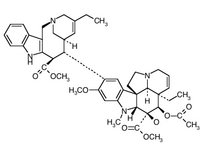Definition
Vinorelbine is a drug used to treat certain types of cancer. Vinorelbine is available under the trade name Navelbine. The drug may also be referred to as vinorelbine tartrate, or didehydrodeoxynorvincaleukoblastine.
Purpose
Vinorelbine is an antineoplastic agent used to treat non-small cell lung carcinoma.
Description
Vinorelbine was approved by the Food and Drug Administration (FDA) in 1994.
Vinorelbine is a semisynthetic derivative of vinblastine, a naturally occurring compound that is extracted from periwinkle plants. It belongs to a group of chemicals called vinca alkaloids. The chemical structure and biological action of vinorelbine is similar to vinblastine and vincristine.
Vinorelbine prevents the formation of microtubules in cells. One of the roles of microtubules is to aid in the replication of cells. By disrupting this function vinorelbine inhibits cell replication, including the replication the cancer cells.
Vinorelbine is used alone and in combination with cisplatin (another anticancer drug) to treat non-small cell lung carcinoma. It has been used in combination with other drugs to treat breast cancer. As of 2000 vinorelbine was under investigation for the treatment for cervical cancer.
Recommended dosage
Vinorelbine is administered by intravenous injection (directly into a vein) once per week. The initial dose may be adjusted downward depending on patient tolerance to the toxic side effects of treatment. If toxic effects are severe, vinorelbine treatment may be delayed or discontinued.
Precautions
Vinorelbine must only be administered by individuals experienced in the use of this cancer chemotherapeutic agent. Vinorelbine must only be administered intravenously. Accidental administration of vinorelbine into the spinal cord fluid is a medical emergency that may result in death. Vinorelbine has a low therapeutic index, which means it is unlikely there will be therapeutic benefit without toxic side effects. Certain complications can only be managed by a physician experienced in the use of cancer chemotherapeutic agents.
Because vinorelbine is administered intravenously and is extremely irritating, the site of infusion and surrounding tissue should be monitored for signs of inflammation.
Blood tests are recommended to ensure that bone marrow function and the number of white blood cells is adequate for treatment to continue. Infections should also be controlled before vinorelbine treatment starts. Special caution should be used with patients whose bone marrow reserves have been reduced by previous radiation or chemotherapy treatment.
Vinorelbine may cause harm to a fetus when administered to pregnant women. Only in life-threatening situations should this treatment be used during pregnancy. Women of childbearing age are advised not to become pregnant during treatment. Women should stop nursing before beginning treatment due to the potential for serious adverse side effects in the nursing infants.
The safety of vinorelbine in children under 18 years of age has not been established.
Side effects
The side effects of vinorelbine treatment are usually related to the dose of drug and are generally reversible. It is possible that toxic side effects may be more common in patients with poor liver function, and should be used with caution in those patients.
Decreased bone marrow function is the principal adverse side effect. This can reduce the number of white blood cells and increase the chance of infections. Patients should report fever or chills to their doctors immediately. Patients should also inform their doctor if they experience abdominal pain, constipation, or an increase in shortness of breath.
Toxicity of the nervous system is another side effect. Shortness of breath is a potentially severe side effect that patients should report to their doctor. Additional side effects, including fever, anemia, an increase or decrease in blood pressure, dizziness, nausea and vomiting, hearing impairment, and hair loss (alopecia) may occur.
Interactions
The use of vinorelbine in combination with another anticancer drug, mitomycin-C, has caused severe shortness of breath. Patients taking vinorelbine and cisplatin are more likely to experience a decrease in the number of white blood cells. This side effect should be carefully monitored to ensure that the number of white blood cells is adequate for treatment to continue. Patients taking vinorelbine and another anticancer drug, paclitaxel, may be more likely to experience toxicity of the nervous system, and should be carefully monitored for this. Drugs that may alter the metabolism of vinorelbine should be used with caution due to the potential for interactions.
KEY TERMS
- Alkaloid
- A nitrogen-containing compound occurring in plants.
- Microtubles
- A tubular structure located in cells that help them to replicate.
- Therapeutic index
- A ratio of the maximum tolerated dose of a drug divided by the dose used in treatment.



